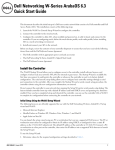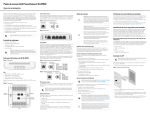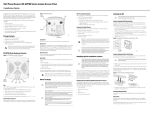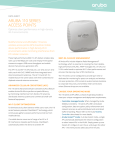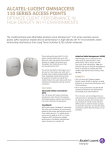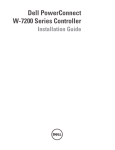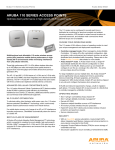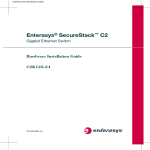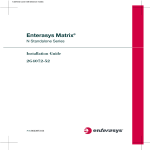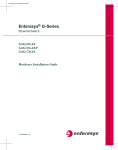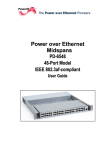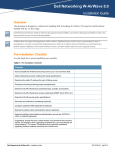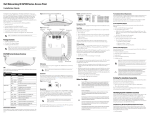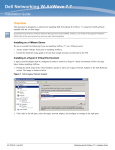Download Dell PowerConnect W-AP114/115 Installation Manual
Transcript
Dell Networking W-AP110 Series Access Point Installation Guide The Dell Networking W-AP110 Series (W-AP114 and W-AP115) wireless access points (AP) support the IEEE 802.11n standard for high-performance WLAN. They use MIMO (Multiple-in, Multiple-out) technology and other high-throughput mode techniques to deliver high-performance, 802.11n 2.4 GHz and 5 GHz functionality while simultaneously supporting existing 802.11a/b/g wireless services. The W-AP110 Series access point works only in conjunction with an Dell Networking W-Series mobility controller. Figure 2 W-AP110 Series Side View (W-AP114 shown) ANT2 Figure 5 Gigabit Ethernet Port Pin-Out ANT1 ANT0 1000Base-T Gigabit Ethernet Port RJ-45 Female Pin-Out 1 2 3 4 5 6 7 8 The W-AP110 Series access point provides the following capabilities: Wireless transceiver Protocol-independent networking functionality IEEE 802.11a/b/g/n operation as a wireless access point IEEE 802.11a/b/g/n operation as a wireless air monitor Compatibility with IEEE 802.3at PoE+ and 802.3af PoE Central management configuration and upgrades through a Dell controller Note: The W-AP110 Series requires Dell Networking W-Series ArubaOS 6.3.1.0 or later. Package Contents W-AP114 or W-AP115 access point 9/16" and 15/16” ceiling rail adapters Installation guide (this document) USB Port External Antenna Connectors The W-AP114 access point is equipped with three external antenna connectors. The connectors are labeled ANT0, ANT1, and ANT2 and correspond to radio chains 0, 1, and 2. 5 GHz: Indicates the status of the 5 GHz (802.11a/n) radio 2.4 GHz: Indicates the status of the 2.4 GHz (802.11b/g/n) radio Table 1 LED Behavior Color/State Meaning PWR Off No power to AP Red Initial power-up Green - Flashing AP booting Green - Steady AP ready Off Ethernet link unavailable Yellow - Steady 10/100Mbps Ethernet link established Green - Steady 1000Mbps Ethernet link established Flashing Ethernet link activity Off 5 GHz radio disabled Yellow - Steady 5 GHz radio enabled in non-HT WLAN mode Green - Steady 5 GHz radio enabled in HT WLAN mode Flashing - Green 5 GHz Air or Spectrum Monitor Off 2.4 GHz radio disabled Yellow - Steady 2.4 GHz radio enabled in non-HT WLAN mode Green - Steady 2.4 GHz radio enabled in HT WLAN mode Flashing - Green 2.4 GHz Air or Spectrum Monitor ENET 5 GHz 2.4 GHz One of the following network services: Aruba Discovery Protocol (ADP) DNS server with an “A” record DHCP Server with vendor-specific options Summary of the Setup Process Successful setup of a W-AP110 Series access point consists of five tasks, which must be performed in this order: 1. Verify pre-installation connectivity. 2. Identify the specific installation location for each AP. 3. Install each AP. Center-positive 1.7/4.0 mm circular plug, 9.5 mm length 5. Configure each AP. USB Interface Reset Button The W-AP110 Series access point is equipped with a USB interface for connectivity with cellular modems. The reset button can be used to return the W-AP110 Series access point to factory default settings. To reset the AP: Note: Dell, in compliance with governmental requirements, has designed the WAP110 Series access points so that only authorized network administrators can change the settings. For more information about AP configuration, refer to the Dell Networking W-Series ArubaOS Quick Start Guide and Dell Networking W-Series ArubaOS User Guide. 1. Power off the AP. 2. Press and hold the reset button using a small, narrow object, such as a paperclip. 3. Power-on the AP without releasing the reset button. The power LED will flash within 5 seconds. Figure 3 W-AP110 Series Rear View Caution: Access points are radio transmission devices and as such are subject to governmental regulation. Network administrators responsible for the configuration and operation of access points must comply with local broadcast regulations. Specifically, access points must use channel assignments appropriate to the location in which the access point will be used. 4. Release the reset button. The power LED will flash again within 15 seconds indicating that the reset is completed. The AP will now continue to boot with the factory default settings. Before You Begin Caution: FCC Statement: Improper termination of access points installed in the United States configured to non-US model controllers will be in violation of the FCC grant of equipment authorization. Any such willful or intentional violation may result in a requirement by the FCC for immediate termination of operation and may be subject to forfeiture (47 CFR 1.80). Caution: EU Statement: Lower power radio LAN product operating in 2.4 GHz and 5 GHz bands. Please refer to the Dell Networking W-Series ArubaOS User Guide for details on restrictions. Produit réseau local radio basse puissance operant dans la bande fréquence 2.4 GHz et 5 GHz. Merci de vous referrer au Dell Networking W-Series ArubaOS User Guide pour les details des restrictions. Low Power FunkLAN Produkt, das im 2.4 GHz und im 5 GHz Band arbeitet. Weitere Informationen bezlüglich Einschränkungen finden Sie im Dell Networking W- Series ArubaOS User Guide. Console Port LED Layer 2/3 network connectivity to your access point 4. Verify post-installation connectivity. 2.4GHz 5GHz ENET PWR 12 VDC (+/- 5%)/18W The W-AP110 Series access point is equipped with four LEDs that indicate the status of the various components of the AP. ENET: Indicates the status of the Ethernet (ENET) port Dell controller provisioned on the network: LEDs negative) negative) positive) positive) positive) positive) negative) negative) Additionally, a locally-sourced AC-to-DC adapter (or any DC source) can be used to power this device, as long as it complies with all applicable local regulatory requirements and the DC interface meets the following specifications: Figure 1 W-AP110 Series LEDs PWR: Indicates whether or not the AP is powered-on (POE (POE (POE (POE (POE (POE (POE (POE If PoE is not available, an optional Dell AP AC-DC adapter kit (sold separately) can be used to power the W-AP110 Series access point. W-AP110 Series Hardware Overview ETH Rx+ ETH RxETH Tx+ Spare Pair Spare Pair ETH TxSpare Pair Spare Pair DC Power Socket Note: The USB interface is disabled when the W-AP110 Series access point is powered from 802.3af PoE. Note: Inform your supplier if there are any incorrect, missing, or damaged parts. If possible, retain the carton, including the original packing materials. Use these materials to repack and return the unit to the supplier if needed. The serial console port allows you to connect the W-AP110 Series access point to a serial terminal or a laptop for direct local management. This port is a RJ-45 female connector with the pinouts described in Figure 4. Connect it directly to a terminal or terminal server using an Ethernet cable. Figure 4 Serial Port Pin-Out Serial Console Port Apparati Radio LAN a bassa Potenza, operanti a 2.4 GHz e 5 GHz. Fare riferimento alla Dell Networking W-Series ArubaOS User Guide per avere informazioni detagliate sulle restrizioni. Pre-Installation Network Requirements RJ-45 Female Pin-Out 1 2 3 4 5 6 7 8 TxD GND GND RxD Ethernet Port The W-AP110 Series access point is equipped with one 10/100/1000Base-T (RJ-45) auto-sensing, MDI/MDX wired-network connectivity port. This port supports IEEE 802.3af and 802.3at Power over Ethernet (PoE) compliance, accepting 48 VDC (nominal) as a standard defined Powered Device (PD) from a Power Sourcing Equipment (PSE) such as a PoE midspan injector, or network infrastructure that supports PoE. The port has RJ-45 female connectors with the pin-outs shown in Figure 5. After WLAN planning is completed and the appropriate products and their placement have been determined, the Dell controller(s) must be installed and initial setup be performed before the Dell APs are deployed. For initial setup of the controller, refer to the Dell Networking W-Series ArubaOS Quick Start Guide corresponding to the software version installed on the controller. AP Pre-Installation Checklist Before installing the W-AP110 Series access point, ensure that you have the following: CAT5e or better UTP cable of required length One of the following power sources: IEEE 802.3at or 802.3af-compliant Power over Ethernet (PoE) source. The POE source can be any power source equipment (PSE) controller or midspan PSE device Dell AP AC-DC adapter kit (sold separately) Verifying Pre-Installation Connectivity Before you install the W-AP110 Series access points in a network environment, make sure that they can locate and connect to the controller after power on. Specifically, you must verify the following conditions: When connected to the network, each AP is assigned a valid IP address APs can locate the controller Refer to the Dell Networking W-Series ArubaOS Quick Start Guide for instructions on locating and connecting to the controller. Identifying Specific Installation Locations You can mount the W-AP110 Series access point on a wall or on the ceiling. Use the AP placement map generated by the Dell Airwave VisualRF Plan software application to determine the proper installation location(s). Each location should be as close as possible to the center of the intended coverage area and should be free from obstructions or obvious sources of interference. These RF absorbers/reflectors/ interference sources will impact RF propagation and should have been accounted for during the planning phase and adjusted for in VisualRF plan. Identifying Known RF Absorbers/Reflectors/Interference Sources Identifying known RF absorbers, reflectors, and interference sources while in the field during the installation phase is critical. Make sure that these sources are taken into consideration when you attach an AP to its fixed location. Examples of sources that degrade RF performance include: Cement and brick Objects that contain water Metal Microwave ovens Wireless phones and headsets Installing the AP Configuring the AP Safety and Regulatory Compliance AP Provisioning/Reprovisioning Note: Service to all Dell Networking products should be performed by trained service personnel only. Using the Ceiling Rail Adapter The W-AP110 Series access point ships with two ceiling rail adapters for 9/16” and 15/16” ceiling rails. Additional wall mount adapters and ceiling rail adapters for other rail styles are available as accessory kits. Caution: Make sure the AP fits securely on the ceiling tile rail when hanging the device from the ceiling, because poor installation could cause it to fall onto people or equipment. 1. Pull the necessary cables through a prepared hole in the ceiling tile where the AP will be placed. 2. Place the adapter against the back of the AP at an angle of approximately 30 degrees to the tabs (see Figure 6). 3. Twist the adapter clockwise until it snaps into place in the tabs (see Figure 6). Figure 6 Attaching the Ceiling Rail Adapter Provisioning parameters are unique to each AP. These local AP parameters are initially configured on the controller which are then pushed out to the AP and stored on the AP itself. Dell recommends that provisioning settings be configured via the ArubaOS Web UI only. Refer to the Dell Networking W-Series ArubaOS User Guide for complete details. Dell provides a multi-language document that contains country-specific restrictions and additional safety and regulatory information for all Dell hardware products. The Dell Networking W-Series Safety, Environmental, and Regulatory Information document is included with this product. Regulatory Model Names The following regulatory model names apply to the W-AP110 Series access points: W-AP114: APIN0114 AP Configuration W-AP115: APIN0115 Configuration parameters are network or controller specific and are configured and stored on the controller. Network configuration settings are pushed out to the AP(s) but remain stored on the controller. FCC Configuration settings can be configured via the Dell Networking W-Series ArubaOS WebUI or CLI. Refer to the Dell Networking W-Series ArubaOS User Guide and/or Dell Networking W-Series ArubaOS Command Line Interface Reference Guide for complete details. 1. Log into the controller WebUI. 2. Navigate to Maintenance > Controller > About. Caution: RF Radiation Exposure Statement: This equipment complies with FCC RF radiation exposure limits. This equipment should be installed and operated with a minimum distance of 7.9 inches (20 cm) between the radiator and your body for 2.4 GHz and 5 GHz operations. This transmitter must not be co-located or operating in conjunction with any other antenna or transmitter. When operated in the 5.15 to 5.25 GHz frequency range, this device is restricted to indoor use to reduce the potential for harmful interference with co-channel Mobile Satellite Systems. Electrical Ethernet: 1x 10/100/1000Base-T auto-sensing Ethernet RJ-45 Interface MDI/MDX IEEE 802.3 (10Base-T), IEEE 802.3u (100Base-T). IEEE 802.3ab (1000Base-T) Power over Ethernet (IEEE 802.3at and 802.3af compliant), 48V DC (nominal) and 56V DC (maximum)/350mA (see Figure 5 for pin configuration) Power: 12 VDC power interface, supports powering through an AC-to-DC power adapter POE support on Ethernet ports: 802.3at-compliant and 802.3af-compliant POE sourcing devices AP-110_04 4. If necessary, connect the console cable to the console port on the back of the AP. 5. Hold the AP next to the ceiling tile rail with the ceiling tile rail mounting slots at approximately a 30-degree angle to the ceiling tile rail (see Figure 7). Make sure that any cable slack is above the ceiling tile. 6. Pushing toward the ceiling tile, rotate the AP clockwise until the device clicks into place on the ceiling tile rail. Main Website dell.com This device complies with Part 15 of the Federal Communications Commission (FCC) Rules. Operation is subject to the following two conditions: Support Website dell.com /support Documentation Website dell.com /support/manuals 1. This device may not cause harmful interference. 2. This device must accept any interference received, including interference that may cause undesired operation. Caution: Changes or modifications to this unit not expressly approved by the party responsible for compliance could void the user’s authority to operate this equipment. This equipment has been tested and found to comply with the limits for a Class B digital device, pursuant to Part 15 of the FCC Rules. This equipment generates, uses and can radiate radio frequency energy and, if not installed and used in accordance with the manufacturer’s instructions, may cause interference harmful to radio communications. Reorient or relocate the receiving antenna. Dispose of Dell equipment per local regulations. For the most current information about Global Environmental Compliance and Dell products, visit dell.com. Increase the separation between the equipment and receiver. Connect the equipment to an outlet on a circuit different from that to which the receiver is connected. Waste of Electrical and Electronic Equipment Consult the dealer or an experienced radio or TV technician for help. Dell products at end of life are subject to separate collection and treatment in the EU Member States, Norway, and Switzerland and therefore are marked with the symbol shown at the left (crossed-out wheelie bin). The treatment applied at end of life of these products in these countries shall comply with the applicable national laws of countries implementing Directive 2002/96EC on Waste of Electrical and Electronic Equipment (WEEE). European Union RoHS Complies with the Class B limits for radio noise emissions as set out in the interference-causing equipment standard entitled “Digital Apparatus,” ICES-003 of Industry Canada. Cet apareil numerique de la classe B respecte toutes les exigencies du Reglement sur le materiel brouilleur du Canada. Users are advised that high power Radars are allocated as primary users of the bands 5250-5350 MHz and 5650-5850 MHz and these Radars could cause interference and/or damage to Licensed Exempt WLAN devices. EU Regulatory Conformance Aruba Networks Inc., hereby, being the manufacturer of this product, declares that all CE Marked Dell wirless controller and access points products are manufactured in accordance to the provisional requirements set forth in the RoHS Directive 2011/65/EC. AP-110_005 A copy of the Aruba Declaration of Conformity may be obtained upon request from: 7. On the W-AP114 access point, install the external antennas according to the manufacturer’s instructions, and connect the antennas to the antenna interfaces on the AP. © 2013 Aruba Networks, Inc. Aruba Networks trademarks include , Aruba Networks®, Aruba Wireless Networks®, the registered Aruba the Mobile Edge Company logo, and Aruba Mobility Management System®. Dell™, the DELL™ logo, and PowerConnect™ are trademarks of Dell Inc. All rights reserved. Specifications in this manual are subject to change without notice. Originated in the USA. All other trademarks are the property of their respective owners. Open Source Code Certain Aruba products include Open Source software code developed by third parties, including software code subject to the GNU General Public License (GPL), GNU Lesser General Public License (LGPL), or other Open Source Licenses. The Open Source code used can be found at this site: http://www.arubanetworks.com/open_source Includes software from Litech Systems Design. The IF-MAP client library copyright 2011 Infoblox, Inc. All rights reserved. This product includes software developed by Lars Fenneberg, et al. Legal Notice The use of Aruba Networks, Inc. switching platforms and software, by all individuals or corporations, to terminate other vendors’ VPN client devices constitutes complete acceptance of liability by that individual or corporation for this action and indemnifies, in full, Aruba Networks, Inc. from any and all legal actions that might be taken against it with respect to infringement of copyright on behalf of those vendors. Medical Please include the regulatory model number located on the product’s regulatory nameplate with the request. 1. Equipment not suitable for use in the presence of flammable mixtures. 2. End product system, including power supply, must be evaluated to IEC 60601-1-1 and IEC 60601-1 by the end user. China RoHS 3. Wipe with a dry cloth, no additional maintenance required. 4. No serviceable parts, the unit must be sent back to the manufacturer for repair. 5. No modifications are allowed without Dell approval. Dell products also comply with China environmental declaration requirements and are labeled with the “EFUP 10” label shown at the left. ᳝↦᳝ᆇ⠽䋼ໄᯢ Hazardous Materials Declaration Connecting Required Cables Install cables in accordance with all applicable local and national regulations and practices. This product is CE marked according to the provisions of the R & TTE Directive (1999/5/EC) - CE(!). Dell, hereby declares that the APIN0114 / APIN0115 device models are in compliance with the essential requirements and other relevant provisions of Directive 1999/ 5/EC -CE(!) Copyright The Declaration of Conformity made under Directive 1999/5/EC is available for viewing at dell.com Aruba Networks International Ltd. Building 1000, Citygate Mahon Cork Ireland 10 Website Support If this equipment does cause interference, which can be determined by turning the equipment off and on, the user is encouraged to try to correct the interference by one or more of the following measures: Proper Disposal of Dell Equipment Figure 7 Mounting the AP Contacting Dell FCC Class B Part 15 Note: If a power adapter other than the one provided by Dell is used in the US or Canada, it should be cULus (NRTL) Listed, with an output rated 12 VDC, minimum 1.25A, marked “LPS” or “Class 2,” and suitable for plugging into a standard power receptacle in the US and Canada. For additional specifications on this product, please refer to the product data sheet at dell.com/support. Installation Guide This device is electronically labeled. To view the FCC ID: Product Specifications Dell Networking W-AP110 Series Access Point 䚼ӊৡ⿄ (Parts) ⬉䏃ᵓ (PCA Boards) ᴎẄ㒘ӊ (Mechanical Sub-Assemblies) ƻ˖ ᳝↦᳝ᆇ⠽䋼ܗ㋴(Hazardous Substance) 䬝 ݁Ӌ䫀 ⒈㘨㣃 &G &U 3%% 䪙 3E ∲ +J h ƻ ƻ ƻ ƻ ƻ h ƻ ƻ ƻ ƻ ƻ ⒈Ѡ㣃䝮 3%'( 㸼⼎䆹᳝↦᳝ᆇ⠽䋼䆹䚼ӊ᠔᳝ഛ䋼ᴤ᭭Ёⱘ䞣ഛ SJ/T11363-2006 ᷛޚ㾘ᅮⱘ䰤䞣㽕∖ҹϟDŽ Indicates that the concentration of the hazardous substance in all homogeneous materials in the parts is Verifying Post-Installation Connectivity The integrated LEDs on the W-AP110 Series access point can be used to verify that the AP is receiving power and initializing successfully (see Table 1). Refer to the Dell Networking W-Series ArubaOS Quick Start Guide for further details on verifying postinstallation network connectivity. below the relevant threshold of the SJ/T11363-2006 standard. h˖ 㸼⼎䆹᳝↦᳝ᆇ⠽䋼㟇ᇥ䆹䚼ӊⱘᶤϔഛ䋼ᴤ᭭Ёⱘ䞣䍙ߎ6-7ᷛޚ㾘ᅮⱘ䰤䞣㽕∖DŽ Indicates that the concentration of the hazardous substance of at least one of all homogeneous materials in the parts is above the relevant threshold of the SJ/T11363-2006 standard. ᇍ䫔ଂП᮹ⱘ᠔ଂѻકᴀ㸼ᰒ⼎կᑨ䫒ⱘ⬉ᄤֵᙃѻકৃ㛑ࣙ䖭ѯ⠽䋼DŽ This table shows where these substances may be found in the supply chain of electronic information products, as of the date of sale of the enclosed product. ℸᷛᖫЎ䩜ᇍ᠔⍝ঞѻકⱘ⦃ֱՓ⫼ᳳᷛᖫᶤѯ䳊䚼ӊӮ᳝ϔϾϡৠⱘ⦃ֱՓ⫼ᳳ ՟བ⬉∴ऩܗഫ䌈݊ѻકϞ ℸ⦃ֱՓ⫼ᳳ䰤া䗖⫼ѢѻકᰃѻકݠЁ᠔㾘ᅮⱘᴵӊϟᎹ The Environment- Friendly Use Period (EFUP) for all enclosed products and their parts are per the symbol shown here. The Environment- Friendly Use Period is valid only when the product is operated under the conditions defined in the product manual. www.dell.com Dell Networking W-AP110 Series Access Point | Installation Guide Part Number 0511492-02 | November 2013



